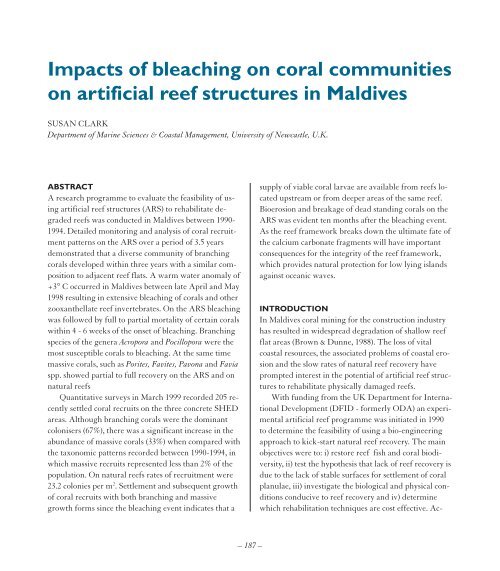You also want an ePaper? Increase the reach of your titles
YUMPU automatically turns print PDFs into web optimized ePapers that Google loves.
Impacts of bleaching on coral communities<br />
on artificial reef structures in Maldives<br />
SUSAN CLARK<br />
Department of Marine Sciences & Coastal Management, University of Newcastle, U.K.<br />
ABSTRACT<br />
A research programme to evaluate the feasibility of using<br />
artificial reef structures (ARS) to rehabilitate degraded<br />
reefs was conducted in Maldives between 1990-<br />
1994. Detailed monitoring and analysis of coral recruitment<br />
patterns on the ARS over a period of 3.5 years<br />
demonstrated that a diverse community of branching<br />
corals developed within three years with a similar composition<br />
to adjacent reef flats. A warm water anomaly of<br />
+3° C occurred in Maldives between late April and May<br />
1998 resulting in extensive bleaching of corals and other<br />
zooxanthellate reef invertebrates. On the ARS bleaching<br />
was followed by full to partial mortality of certain corals<br />
within 4 - 6 weeks of the onset of bleaching. Branching<br />
species of the genera Acropora and Pocillopora were the<br />
most susceptible corals to bleaching. At the same time<br />
massive corals, such as Porites, Favites, Pavona and Favia<br />
spp. showed partial to full recovery on the ARS and on<br />
natural reefs<br />
Quantitative surveys in March 1999 recorded 205 recently<br />
settled coral recruits on the three concrete SHED<br />
areas. Although branching corals were the dominant<br />
colonisers (67%), there was a significant increase in the<br />
abundance of massive corals (33%) when compared with<br />
the taxonomic patterns recorded between 1990-1994, in<br />
which massive recruits represented less than 2% of the<br />
population. On natural reefs rates of recruitment were<br />
23.2 colonies per m 2 . Settlement and subsequent growth<br />
of coral recruits with both branching and massive<br />
growth forms since the bleaching event indicates that a<br />
supply of viable coral larvae are available from reefs located<br />
upstream or from deeper areas of the same reef.<br />
Bioerosion and breakage of dead standing corals on the<br />
ARS was evident ten months after the bleaching event.<br />
As the reef framework breaks down the ultimate fate of<br />
the calcium carbonate fragments will have important<br />
consequences for the integrity of the reef framework,<br />
which provides natural protection for low lying islands<br />
against oceanic waves.<br />
INTRODUCTION<br />
In Maldives coral mining for the construction industry<br />
has resulted in widespread degradation of shallow reef<br />
flat areas (Brown & Dunne, 1988). The loss of vital<br />
coastal resources, the associated problems of coastal erosion<br />
and the slow rates of natural reef recovery have<br />
prompted interest in the potential of artificial reef structures<br />
to rehabilitate physically damaged reefs.<br />
With funding from the UK Department for International<br />
Development (DFID - formerly ODA) an experimental<br />
artificial reef programme was initiated in 1990<br />
to determine the feasibility of using a bio-engineering<br />
approach to kick-start natural reef recovery. The main<br />
objectives were to: i) restore reef fish and coral biodiversity,<br />
ii) test the hypothesis that lack of reef recovery is<br />
due to the lack of stable surfaces for settlement of coral<br />
planulae, iii) investigate the biological and physical conditions<br />
conducive to reef recovery and iv) determine<br />
which rehabilitation techniques are cost effective. Ac-<br />
– 187 –


















